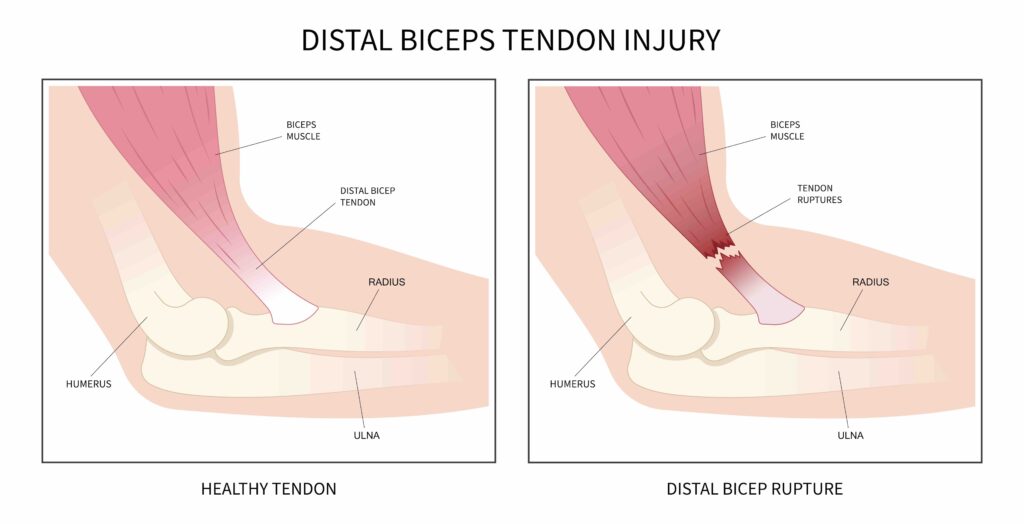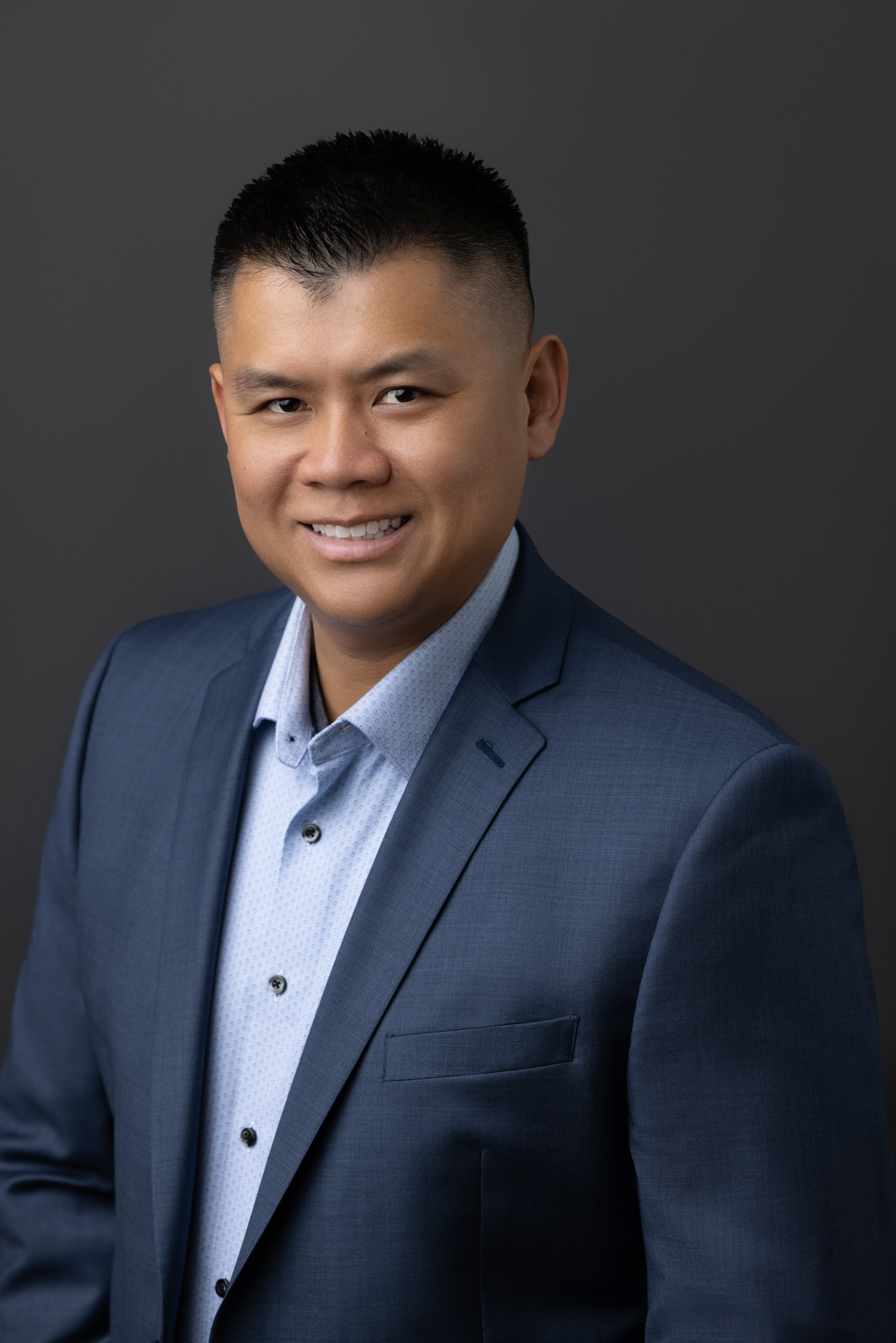What is a distal biceps tendon rupture?
A distal biceps tendon rupture is a type of injury that occurs when the distal biceps tendon, which connects the upper arm bone (humerus) to the elbow, is torn or ruptured. An injury to the biceps tendon commonly occurs when the elbow is straightened against resistance. Distal biceps ruptures are often caused by sports-related activities that require repetitive bending and straightening of the arm, such as weightlifting. It can also occur from a sudden, forceful movement of the arm or elbow.
In this blog post I will discuss more on the causes and symptoms of a distal biceps tendon rupture and what the best treatment options would be. Additionally, I will explain what the recovery might look like and how to best prevent a rupture or further injury to the biceps tendon.
Causes
The distal biceps tendon is a fibrous tissue that attaches the biceps (the muscle of the upper arm) to the radius (the bone located just below the elbow). A rupture in the distal biceps tendon may be full or partial. A full rupture is the more common of the two and causes the tendon to completely separate from the radius. A partial rupture leaves some tissue attached to the bone.

A rupture in the distal biceps tendon is typically caused by an injury or overuse. The most common cause of distal biceps tendon rupture is from forceful straightening of the elbow against resistance. This type of injury often occurs when lifting a heavy object, such as with biceps curls or pull-ups, weight lifting, or playing a contact sport like boxing or wrestling. It can also occur from a direct impact to the elbow, such as when falling onto an outstretched arm.
Symptoms
Symptoms of distal biceps tendon ruptures may include immediate and severe pain in the elbow area, as well as swelling and bruising around the elbow joint. You may find that you are unable to fully bend your elbow and may experience weakness when bending or straightening your arm, especially when rotating your palm face up. Simple tasks such as turning a doorknob or twisting a screwdriver can be difficult.
Full distal biceps tendon ruptures usually causes the biceps muscle to move toward the shoulder, creating a bulge in the upper arm. With a partial rupture, less swelling and bruising may occur.
Treatment
After discussing how your injury occurred, Dr. Giang will perform a physical examination, testing your arm strength and feeling for any tendon gaps. If the diagnosis is unclear, imaging testing such as X-ray, ultrasound, or MRI may be recommended to confirm the degree of injury.
Distal biceps tendon ruptures, while uncommon, are most often seen in the dominant arm of men aged 40 to 60. Treatment for partial distal biceps tendon rupture usually begins with non-surgical options such as physical therapy and medications to reduce pain and inflammation. Nonsurgical treatment may help relieve some pain and maintaining some arm function but won’t solve the issue. If these conservative treatments do not provide relief or if there is a full rupture, surgery will most likely be recommended.
Surgery
Because the distal biceps tendon cannot grow back on its own, surgery is necessary to re-attach the tendon to the bone in order to regain full arm strength and function. This procedure involves re-attaching the distal biceps tendon to the humerus bone and if necessary, may involve a graft or replacement tendon. A surgical repair of the tendon should ideally be performed during the first 2 to 3 weeks after injury. After 2 to 3 weeks, the tendon and biceps muscle begins to scar and shorten, making it less possible to restore arm function. Treatment after this time period is still doable, however it becomes more complicated and generally less successful.
Recovery
Recovery from distal biceps tendon rupture can typically take 3 to 4 months. Initially, your arm will be placed in a splint or brace to allow the tendon to heal and avoid re-injury. It is likely that you will be prescribed physical therapy to help you regain strength and range of motion. Depending on the type of surgery performed, rehabilitation may involve a combination of stretching and strengthening exercises, as well as icing and rest.
Recovery can be a slow process, but it is especially important to follow your doctors’ instructions and limit your activities until the tendon has been allowed to fully heal. This includes avoiding heavy lifting and vigorous activities for several months until your doctor clears you to return.
Prevention
The best way to prevent distal biceps tendon rupture is to avoid overuse and lifting objects that are too heavy. Use special care and maintain proper techniques when performing activities that involve repetitive bending and straightening of the arm or forceful movements. It’s also important to warm up before engaging in any physical activity and take regular breaks when engaging in strenuous activities. Exercises to properly strengthen the shoulder, elbow and forearm are an important step to prevent injury. Avoid smoking and steroid use, as these have been shown to weaken the muscles and damage the tissues.
FAQ:
Q: What is distal biceps tendon rupture?
A: Distal biceps tendon rupture is a type of injury that occurs when the distal biceps tendon, which connects the upper arm bone (humerus) to the elbow, is torn or ruptured. An injury to the biceps tendon commonly occurs when the elbow is straightened against resistance.
Q: What are the symptoms of distal biceps tendon rupture?
A: Symptoms of distal biceps tendon rupture may include:
- Swelling in the front of the elbow
- Pain/tenderness on the inner part of the elbow
- Bruising in the elbow and forearm
- Weakness when bending or twisting your elbow and/or forearm
- A gap in the front of the elbow from the absence of the tendon
- A visible bulge in the upper part of the arm created by the recoiled, shortened biceps muscle
Q: What causes a distal biceps tendon rupture to occur?
A rupture in the distal biceps tendon is typically caused by an injury or overuse. The most common cause of distal biceps tendon rupture is from forceful straightening of the elbow against resistance – often seen from heavy weight lifting.
Q: How is distal biceps tendon rupture treated?
A: Treatment for a partial distal biceps tendon rupture usually begins with non-surgical options such as physical therapy and medications to reduce pain and inflammation. If conservative treatment does not provide relief, surgery may be recommended. A full rupture cannot heal or regrow on its own, making surgical intervention necessary to re-attach the tendon to the bone to regain full arm strength and function.
Q: How long is recovery from distal biceps tendon rupture?
A: Recovery from distal biceps tendon rupture can typically take 3 to 4 months. Physical therapy is often recommended to help regain strength and range of motion in the elbow and prevent further injury.
Q: How can distal biceps tendon rupture be prevented?
A: The best way to prevent distal biceps tendon rupture:
- Avoid overuse and lifting objects that are too heavy
- Use special care and maintain proper techniques when performing activities that involve repetitive bending and straightening of the arm or forceful movements
- Warm up before engaging in any physical activity and take regular breaks when engaging in strenuous activities.
- Exercises to properly strengthen the shoulder, elbow and forearm a
- Avoid smoking and steroid use, as these have been shown to weaken the muscles and damage the tissues.
A distal biceps tendon rupture, when left untreated, can limit the full function of your arm. It is important to consult an orthopedic surgeon as soon as you think you’ve sustained this type of injury to begin a treatment plan and return to normal activities.
If you would like to schedule a consultation with Dr. Giang, please give us a call or request an appointment using the form below.
"*" indicates required fields






